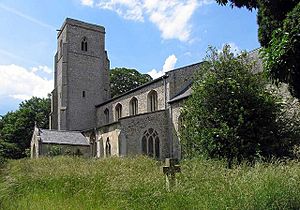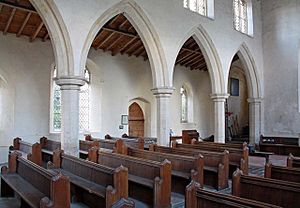St Peter's Church, Hockwold facts for kids
Quick facts for kids St Peter's, Hockwold |
|
|---|---|
 |
|
| Lua error in Module:Location_map at line 420: attempt to index field 'wikibase' (a nil value). | |
| OS grid reference | TL 7249188015 |
| Location | Hockwold cum Wilton, Norfolk |
| Denomination | Anglican |
| Website | Churches Conservation Trust |
| Architecture | |
| Functional status | Redundant |
| Heritage designation | Grade I |
| Designated | 8 July 1959 |
| Specifications | |
| Materials | Flint with ashlar dressings |
St Peter's Church is a very old Anglican church in the village of Hockwold cum Wilton in Norfolk, England. It is no longer used for regular church services, which is why it is called a "redundant church." This special building is protected as a Grade I listed building, meaning it's considered extremely important. The Churches Conservation Trust now takes care of it.
Contents
History of St Peter's Church
St Peter's was once the main church for the village of Hockwold. Later, Hockwold joined with the nearby village of Wilton to form Hockwold cum Wilton. The main part of the church, called the nave, and its tower were built in the mid-1300s. A special area for the altar, known as the chancel, was added in the 1400s.
The church was repaired and updated in 1857. For a long time, St Peter's in Hockwold and St James's in Wilton were separate churches. But from 1666, they shared the same priest, and services took turns between the two churches. Eventually, St Peter's was no longer needed for regular services.
In 1959, the church was officially named a Grade I listed building by English Heritage. A Grade I listing means a building is "of exceptional interest" and sometimes even important worldwide. Today, the Churches Conservation Trust looks after St Peter's, making sure it stays in good condition for everyone to see.
Church Design and Features
Outside the Church
The church is built mostly from flint stones, with smooth, cut stones called ashlar used for details. The roofs are made of slate. The church has a main area (the nave), a side section (south aisle), the chancel, a south porch, and a tower on the southwest side.
The tower has two levels and strong supports called buttresses. It has decorative stone corners known as quoins. There are two-light windows in the belfry (where the bells are) and a similar window on the west side of the tower. The room where the bells are rung has narrow, rounded windows called lancets. In 1805, the tower held three bells.
The church also has windows with three sections in the upper part of the nave, called the clerestory. These windows have special stone patterns. The large east window in the chancel also has three sections and is in the Perpendicular style, with a round, four-leaf shaped window above it.
Inside the Church
Inside, the main part of the church (the nave) is about 14 meters (about 46 feet) long and 11 meters (about 36 feet) wide. The roof has strong wooden beams that cross the space. The south aisle is separated from the nave by a row of four arches, called an arcade. These arches rest on eight-sided pillars.
The south aisle has a stone bench for sitting, called a sedilia, and a small basin for washing communion vessels, called a piscina. The chancel is about 11 meters (about 36 feet) long and 7 meters (about 23 feet) wide. On the south wall of the chancel, there are three stone arches with curved tops. These show where special seats for the bishop, priest, and deacon would have been. There is also another piscina with a curved top. Both these features in the chancel were added in the 1800s.
On the left side of the east window, there is a special stone plaque on the wall. It remembers Sir Cyril Wyche, who passed away in 1780. Sir Cyril was one of the very first members of the Royal Society, a famous group for scientists.
The Churchyard
The area around St Peter's Church, known as the churchyard, also has an important monument. This monument is located about 3 meters (about 10 feet) south of the church tower. It is a square headstone made of ashlar stone and has been given a Grade II listing by English Heritage, meaning it is also a protected historical feature.
More to Explore
- Grade I listed buildings in Norfolk
- List of churches preserved by the Churches Conservation Trust in the East of England


